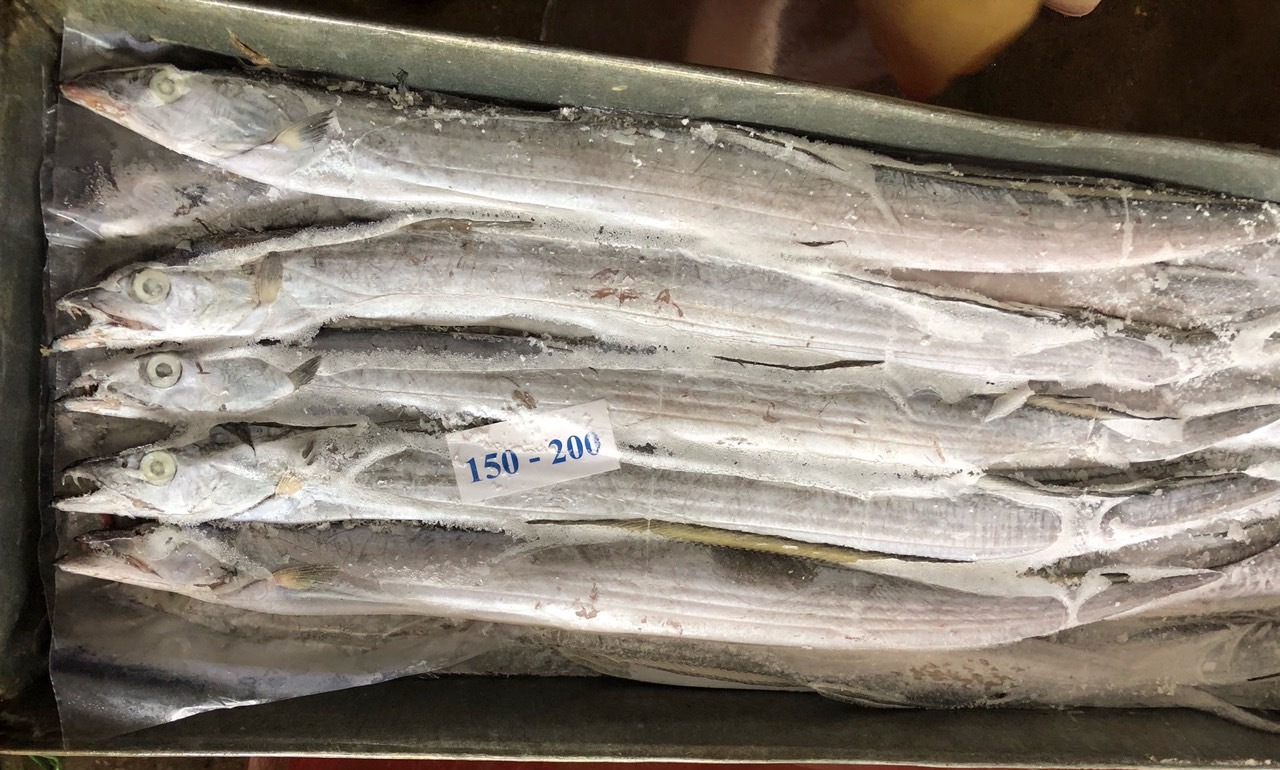
Ribbonfish (scientific name: Trichiurus lepturus), also known as cutlassfish or silver ribbonfish, is a familiar seafood in Vietnam. It’s not just a delicious dish but also a highly potential export commodity. With its distinct flavor, pristine white, flaky meat, minimal bones, and high nutritional value, Vietnamese ribbonfish is increasingly asserting its position in the international market.
1. Abundant Resources Offer Great Potential
Vietnam boasts a long coastline and an extensive exclusive economic zone, creating favorable conditions for the thriving ribbonfish population. Coastal provinces in the Central and Southern regions, such as Quang Ngai, Binh Dinh, Phu Yen, Khanh Hoa, and Ba Ria – Vung Tau, are key fishing grounds, supplying large quantities of high-quality ribbonfish.
The production of ribbonfish caught in Vietnam is quite stable, meeting both domestic consumption and export demands effectively. Fishermen typically use traditional fishing methods like gillnetting and purse seining, ensuring the fish remain fresh and high-quality right from the moment they are caught.

2. Economic and Nutritional Value
Ribbonfish is not only a rich source of protein and omega-3 but also provides essential vitamins (like B12, D) and minerals (like selenium, phosphorus) crucial for the body. This makes ribbonfish a preferred choice for consumers worldwide, especially in demanding markets like Japan and South Korea, where seafood’s nutritional value is highly esteemed.
Economically, ribbonfish generates significant income for fishermen and seafood processing and exporting enterprises. The diversity in processing—from whole frozen ribbonfish, cut ribbonfish portions, ribbonfish fillets, to marinated ribbonfish—has allowed Vietnamese ribbonfish products to reach various customer segments.
3. Key Export Markets
Vietnam’s main ribbonfish importing markets primarily include:
- Asia: Japan, South Korea, China (including Hong Kong), Singapore, Malaysia, Thailand. These are traditional and promising markets with high demand for ribbonfish.
- Europe: Some European countries are also beginning to show interest in Vietnamese ribbonfish, though volumes are not yet as large as the Asian market.

4. Challenges and Opportunities
The Vietnamese ribbonfishs export industry also faces several challenges:
Challenges
- Quality and Food Safety Standards: Importing markets are increasingly stringent about quality standards, antibiotic residues, and food safety. Therefore, enhancing fishing, preservation, and processing procedures is critically important.
- Price Volatility: International ribbonfishs prices can fluctuate due to supply and demand and macroeconomic factors, affecting the profitability of businesses.
- Competition: Ribbonfish is a common species in many countries; thus, Vietnam faces competition from other suppliers such as China, India, or Indonesia.
- Labor Shortages: The seafood industry sometimes struggles to attract and retain young labor, affecting productivity.
Opportunities
- Rising Demand: The global demand for seafood in general, and ribbonfishs in particular, is trending upwards, especially for traceable and high-quality products.
- Processing Technology: Investing in advanced preservation and deep-processing technologies will help increase the added value of Vietnamese ribbonfish products, creating a more diverse range.
- Brand Building: Building a strong brand for Vietnamese ribbonfishs in the international market through promotion and participation in trade fairs and exhibitions.
- Free Trade Agreements (FTAs): Vietnam has signed numerous FTAs, creating favorable tariff conditions, which help ribbonfish products access large markets at more competitive costs.
5. Development Directions for Vietnamese Fishermen and Businesses
To further boost ribbonfish export activities, fishermen and businesses need to focus on the following directions:
For Fishermen
- Improve Catch Quality: Apply modern, sustainable fishing techniques that minimize fish damage and ensure freshness immediately after capture.
- Comply with Regulations: Strictly adhere to food safety regulations and permissible fish sizes to protect resources and meet export standards.
- Invest in Equipment: Equip vessels with proper preservation equipment to keep fish fresh longer and reduce post-catch losses.
- Participate in Value Chains: Closely link with processing and exporting enterprises to ensure stable output and receive support in technology and market information.
For Businesses
- Invest in Deep Processing Technology: Build modern processing plants and lines that meet international standards (e.g., HACCP, BRC, ASC, MSC) to create diverse, high value-added products (fillets, frozen cuts, marinated products…).
- Market Research: Continuously update information on demand, trends, and technical barriers in each importing market to adapt products accordingly.
- Brand Development: Build a strong brand for Vietnamese ribbonfish, promoting the image of high-quality, safe, and sustainable products.
- Market Expansion: Constantly seek and penetrate new markets, especially niche or underexploited ones with potential.
- Build a Sustainable Value Chain: Collaborate closely with fishermen, material suppliers, and logistics partners to optimize costs and ensure quality from catch to consumer.
- Human Resource Training: Enhance the capacity of technical staff, management, and workers in the seafood processing industry to meet the increasingly high demands of the market.
Other agricultural products:


